HistoryPeople that created Pacific Consultants
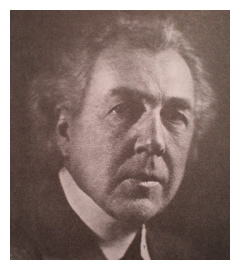
Frank Lloyd Wright (1867 – 1959)
A world-famous virtuoso of modern architecture that overcomes stagnation
One of the three virtuosos of modern architecture. Known for his collection of Ukiyoe and for being a Japanophile, he also contributed to the development of modern architecture in Japan.
In 1917, Frank Lloyd Wright visited Japan with his assistant, Antonin Raymond, to design the new annexe of the Imperial Hotel.
The families of Tashiro Shiraishi, who contributed greatly to the foundation of our company, and Antonin Raymond formed a close friendship following this visit. The design of the Imperial Hotel by the world-famous architect Frank Lloyd Wright was behind the creation of our company as the catalyst for a friendship between Japanese and American engineers.
The Legacy of F.L. Wright
New annexe of the Imperial Hotel (Wright Annexe)
Wright carefully selected everything from stone materials to furniture and poured his soul into designing a radical fire and earthquake resistant structure which was said to be the most beautiful hotel in the world.
His student, Antonin Raymond, later evaluated it as the only hotel in the world to be constructed without commercialism.
It was an imposing, unchanging spectacle with almost no damage after the Great Kanto Earthquake on 1st September, 1923 (the day of the commemorative opening ceremony for the hotel and its annexes) and this gave hope to the Japanese who had been wounded by the disaster.
It should be noted that the old annexe of the Imperial Hotel that was designed by Wright has now been re-built and a part of the original red brick structure has been moved to Meiji-mura where it has been preserved.
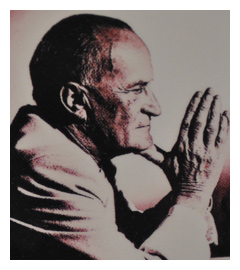
Antonin Raymond (1888 – 1976)
An architect who greatly influenced Japanese architects
An architect who was active in both Japan and the U.S. Born in Bohemia (now the Czech Republic). After the First World War, Raymond was sounded out by Frank Lloyd Wright about going to Japan to design the Imperial Hotel and visited Japan with Wright in 1919.
After the Second World War, he returned to Japan in 1947 to survey a site for dam construction. He jointly established the U.S. corporation, Pacific Consultants Inc. and left a legacy of many masterpieces based on the philosophy of modernism in Japan after the war.
A. Raymond’s Legacy
Tadamigawa Dam Site Survey
One day, after the war, one of his old friends, Tashiro Shiraishi, sent him a letter asking him if he could come to Japan to survey a dam due to the need of Japanese hydro-electric generation. In 1947, directly after this request to go to Japan, he sounded out Five-star General Douglas MacArthur in a letter. The reply from MacArthur evaluated Raymond’s architectural work in Japan as historical and he was soon granted permission to travel to Japan.
(The Architecture of Antonin Raymond, Hiroshi Misawa, Kajima Institute Publishing)
Shiraishi and I met Shigeru Yoshida in his private rooms on a number of occasions to investigate measures and the significance of this basic plan.
Raymond came to Tokyo at the end of October, 1949 with Eric Flores. The first thing he did was to visit General MacArthur, explained that he was going to Okutadami and asked for his opinion on its state, the possibility of building a dam and the creation of a scientific report based on Flores’ survey. (omitted) The General was wearing an open-necked shirt and held an empty, unlit pipe in his right hand. He asked us to sit and listened patiently to our opinions. He interjected at some points with an opinion about an issue and from these opinions, we could see that he grasped the engineering problems that we were facing. He agreed with this work and gave instructions so that we received assistance.
(The Architecture of Antonin Raymond, Hiroshi Misawa, Kajima Institute Publishing)
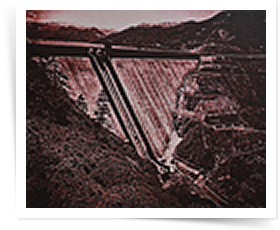
Establishment of Pacific Consultants Inc.
While he was involved in the Tadamigawa development project, a deep mutual understanding developed between Eric Flores and the members of the Tuesday Club Consultation Office which met to put all their efforts into rebuilding Japan after the war. Flores appealed to Muneshiro Shiraishi and Fukujiro Hirayama saying, ‘Japanese engineers are brilliant. It would be great if we could work together as consultants. There will definitely be situations that require consulting engineers in both Japan and the East in the near future. I think it would be wonderful if we could do American-style consulting in these situations.’
Meanwhile, the members of the Tuesday Club Consultation Office, in particular, Fukujiro Hirayama, already had deep knowledge as a consulting engineer and, in order to develop Japanese technology and Japan itself, he even advocated the urgent introduction of the Western-style consulting engineer system and this proposition was the best opportunity one could ask for.
In September, 1951, the U.S. corporation, Pacific Consultants Inc. was inaugurated. This was the birth of the predecessor of Pacific Consultants Co., Ltd. The headquarters of Pacific Consultants Inc. was set up at 129 South State Street, Dover, Kent County in the state of Delaware, of the U.S. Capital was 3,000 dollars. It was a U.S. capital company created with the equal investments of Muneshiro Shiraishi and Eric Flores as well as Antonin Raymond.
(The 25-year History of Pacific Consultants, published by Pacific Consultants Co., Ltd.)
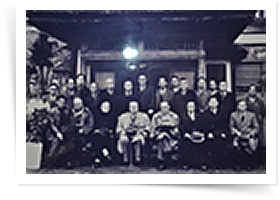
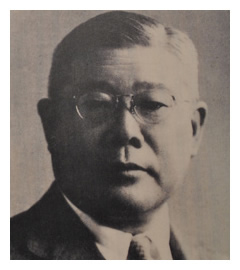
Tashiro Shiraishi
The uncle of the Shiraishi brothers, Tashiro and Muneshiro was Shigeru Yoshida who later became the Prime Minister. Tashiro Shiraishi’s range of activities was broad. In 1921, he became the first president of Komatsu Ltd. and in 1925, he used the pneumatic caisson method for the construction of the foundations of Eitaibashi Bridge, a first in Japan. In addition, he authored the first golf textbook in Japan, Correct Golf, in 1931.
Tashiro went to the U.S. to study architectural techniques which were half a century in advance of those in Japan and, while he was there, he made the acquaintance of many engineers, architects and business people. It is thought that he became friends with Raymond at this time. There is also the theory that Tashiro’s friendship with Raymond began through golf in Japan as Raymond joined the Tokyo Golf Club in 1921.
The Legacy of Tashiro Shiraishi
Establishment of the Tuesday Club Consultation Office
In January, 1948, Tashiro and other engineers, who had clubbed together after the war to lament the nation that had been devastated, received a letter from this unique friend, Raymond. ‘I am very fond of Japan. From what I hear, Japan is now in great difficulty and I would like to do anything I can to help. Please let me know what I can do or tell me how things are there.’ Tashiro and the others sent the following reply to Raymond. ‘There are two things that we must do for Japan now as engineers. The first is the development of electric power since there is a severe lack at the moment and the other is to increase the production of coal.’
Raymond visited Japan in the autumn of 1948 and Tashiro and the others told him about their plan for the development of the Tadamigawa dam. He agreed considerably with the plan but he recommended that it was essential to have a survey and report from a prestigious American consulting engineer in order to proceed with the plan. In June of 1949, they received a communication from Raymond saying that Eric Flores of Westinghouse International was coming to Japan.
Before Flores came to Japan, Tashiro and the others named the group that was involved in activities overseas, the Tuesday Club Consultation Office on July 1st, 1949. This Tuesday Club Consultation Office was set up in Room 424 of the Maru Building, the Shiraishi Foundation Headquarters and later became the matrix to establish Pacific Consultants Co., Ltd.
Raymond came to Japan with Flores in October, 1949 and at the beginning of November, they conducted the Tadamigawa site survey with Fukujiro Hirayama, Muneshiro Shiraishi, Yayoimi Fukihara and Yasuo Kawano.
(taken from The Brief Life of Tashiro Shiraishi, Shunta Shiraishi, published by Tashi Real Estate)
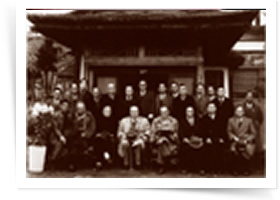
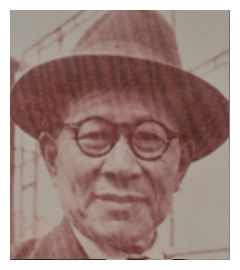
Fukujiro Hirayama
Graduated from the Civil Engineering Department of the Faculty of Engineering at Tokyo Imperial University in 1912 (Tashiro Shiraishi was a classmate) and joined the Railway Board, retiring as director of the architectural department in 1937. After the war, he successively served as president of P.S. Concrete and Pacific Consultants as well as chairman of the Institution of Professional Engineers, Japan.
The Legacy of Fukujiro Hirayama
Establishment of the Professional Engineer System
The Tuesday Club Consultation Office was organized and the Shiraishi brothers, Tashiro and Muneki, and Fukujiro Hirayama et al., who had acquainted themselves with the civil engineering technology societies of the countries of the West, decided to establish the Professional Engineer System, considering that the introduction of Western-style consulting businesses and consulting engineering systems was indispensable to the nature of post-war engineers.
These were required qualifications for an engineer but the work of an engineer is brought about by trusting relationships and faith in the person making the request in the same way as for doctors and lawyers and in order to undertake this work, there must be no insufficiencies in the personality of the person as an engineer as well as having enough knowledge and experience of one’s own professional technology. (omitted) An engineer must have professional knowledge of his technology, backed up by plenty of actual experience.
It is unclear what level of understanding the engineers had of the Consulting Engineer Act but (omitted) there are no benefits to having a monopoly on a profession. In other words, even though it is a qualification law, it is not a regulatory issue and therefore no more than an assisting law due to its monopoly of the name.
The basis of requests to engineers is trust in their technical and professional intellect therefore, it is more or less absurd to base the choice of an engineer on competing bids such as amount of remuneration. The choice must be based on negotiations with an engineer in whom you have complete trust.
(Essay – Living Construction, Fukujiro Hirayama, issued by Sankaido)
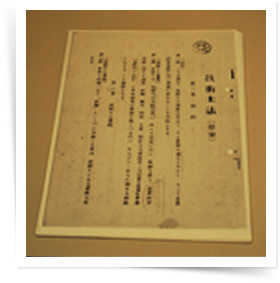
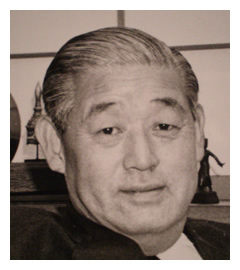
Yasuo Kawano
Graduated from the Civil Engineering Department of the Faculty of Engineering at Tokyo Imperial University in 1933 and joined the Ministry of Railways, retiring from the Ministry of Transport in 1946. After the war, he successively served as president of Pacific Consultants as well as chairman of the Association of Consulting Engineers, Japan.
The activities of Kawano at the Ministry of Railways gained the attention of the civil engineering world from the time when he started work as the head of the Tanna Engineering Group in the Atami Regional Facilities Department in 1941. At the age of only 32, Kawano was in charge of hundreds of staff and he became a man who was in the spotlight for this astuteness. His first job was as site supervisor for the Shin-Tanna Tunnel for the bullet train. It became a major artery for the transportation of commodities and military personnel from Tokyo to Shimonoseki. (omitted) Under direction from Kawano, the construction was suspended in January, 1944 due to the worsening situation of the war with 600m excavated from Atami on the east entrance and 2,400m excavated from Mishima on the west entrance.
(taken from Consultant Biography Series - Yasuo Kawano Edition, Motoaki Takahashi, Japan Civil Engineering Consultants Association Quarterly, Tomorrow’s JCCA)
The Legacy of Yasuo Kawano
Service to the International Community
The first step to Kawano’s overseas activities was his trip to the U.S. in March, 1954. Kawano, who became Executive Director and Chief Engineer of the newly-founded Pacific Consultants, was appointed as a consultant to explain the situation in order to get financing from the World Bank for a radical large-scale project to plan a water business in Aichi which was started with the sponsorship of the Ministry of Agriculture and Forestry.
Following this, he started to work energetically on overseas assignments in parallel with domestic projects. ‘We are prepared to make technology our life’s work but in order to do this our technology must be valid on the international level.’ Service to the international community with this technology was the basic concept of Kawano et al. (omitted)
In April, 1974, as a result of working hard on the establishment and operation of the Association of Consulting Engineers, Japan, it was authorized as an incorporated association in August, 1977. Kawano served as director then chairman from the time it was established and took great pains to carve out an international position for Japanese consultants. As a result, the Association of Consulting Engineers, Japan joined the International Federation of Consulting Engineers (FIDIC) in October, 1974. In the following years, with the recommendation and approval of member country committee members, Kawano became the first Japanese person to be appointed to the FIDIC Executive Committee.
(taken from Consultant Biography Series - Yasuo Kawano Edition, Motoaki Takahashi, Japan Civil Engineering Consultants Association Quarterly, Tomorrow’s JCCA)

